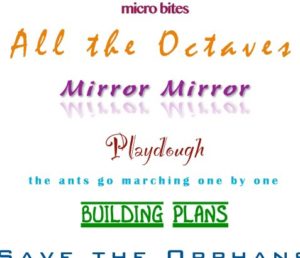Building Habits Or Correcting Mistakes?
 Teacher: How did your practicing go this week?
Teacher: How did your practicing go this week?
Student: Good.
Teacher: How did you practice __________________?
Student: I played it over and over for an hour everyday and always went back and corrected my mistakes. But, it hasn’t gotten much better
Teacher: Did you use the practice steps we worked on together?
Student: Blank stare…
Teacher opens student’s notebook: They are right here. (tactfully doesn’t add the fact that they are in the student’s own handwriting)
Student: Blank stare…
I’m sure nothing like this has ever happened to you. But, just in case it has, here are some ideas that might help.
- Remember that students are learning practice strategies and habits not just pieces. In order to build these habits, parents must be on board too. You must communicate how practicing is different than playing and why they need to put up with some occasionally pretty annoying types of repetition.
- Start a practice toolbox page in the student’s notebook. Have students list practice strategies there as they learn them.
- Students need to learn to use the right tools for the right jobs. Give your students short excerpts from repertoire. Ask them to experiment with different practice strategies and talk with them about why they think some worked and others did not.
- Practicing for an hour doesn’t guarantee success. Playing something 100 times doesn’t either. You can get really, really good at doing something really, really wrong if you aren’t careful. Add a notebook page or separate chart just to track good practice habits. That way, the emphasis isn’t on a laundry list of tasks. It’s focused on the process of going about those tasks.
- Students will hit the proverbial wall if they haven’t built a repertoire of practice strategies by the time they reach the late intermediate stage. Be on the lookout for this in transfer students. I incorporate it into my interviews using no. 3 above.
- Use a smart phone or tablet to create a short video demo of a practice strategy in use. If you use the student’s device, there is no need to share it. If you use your device, you can share via Email, SoundCloud, Dropbox, YouTube, etc. (I do not share videos with anyone but the student and their parents for privacy reasons.) It’s useful to include some footage of the student using the strategy in addition to your demo of it.
Some people love to keep practice journals. Others not so much. As usual you need to find what motivates each student. I am totally against keeping a practice log just to track minutes spent per task. That form of record is like a mileage log for your car or bike. Sure, you know how far you have gone but aren’t where you went, what you saw, and how you felt about it the most important things?
There’s a group of people who actually like journaling but will shut down completely if there is a possibility that someone else will read their personal thoughts. They feel way too vulnerable and unsure which sometimes shows up as hostility or arrogance. (And, why do you really have to read their journaling? Would you read someone’s personal diary?) I find if I share what I have discovered musically in my life and practice with them, they will eventually begin to share their musical selves with me verbally and that is fine with me.
I’d like to share a couple of apropos articles that really resonated with me this week. The first Can Reading Logs Ruin Reading for Kids? by Erica Reischer was shared by Elissa Milne. The second, The Floating Fermata is by Graham Fitch and you should add the Floating Fermata to your practice tool kit right away!
If you want a handy, user friendly resource of practice tools, head on over to Fistful of Notes and check out Tools for Positive Practice. (And, you can download a free My Great Practice Choices chart!) Discover Block Towers, Playdough, Save the Orphans, The Ants Go Marching One By One, Micro-Bites, Tilt-A-Whirl, and more. Which tools will you need today?


